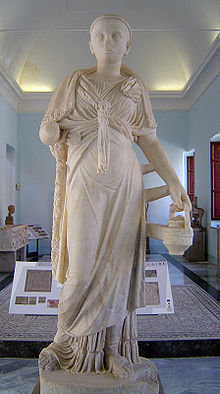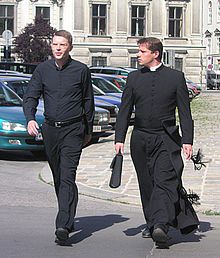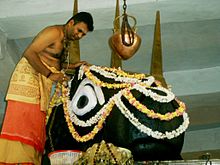Priest
This article needs additional citations for verification. (March 2007) |


A priest or priestess is a person having the authority or power to administer religious rites; in particular, rites of sacrifice to, and propitiation of, a deity or deities. Their office or position is the priesthood, a term which may also apply to such persons collectively.
Priests and priestesses have been known since the earliest of times and in the simplest societies. They exist in all or some branches of Judaism, Christianity, Shintoism, Hinduism, and many other religions, as well, and are generally regarded as having good contact with the deities of the religion to which they subscribe, often interpreting the meaning of events, performing the rituals of the religion, and to whom other believers often will turn for advice on spiritual matters.
In many religions, being a priest or priestess is a full-time job, ruling out any other career. In other cases it is a part-time role. For example in the early history of Iceland the chieftains were entitled goði, a word meaning "priest". But as seen in the saga of Hrafnkell Freysgoði, being a priest consisted merely of offering periodic sacrifices to the Norse gods and goddesses. it was not a full time job, nor did it involve ordination.
In some religions, being a priest is by human election or human choice. In others the priesthood is inherited in familial lines.
Women officiating in modern Paganism, Neopagan religions such as Wicca, and various Polytheistic Reconstructionism faiths are referred to as priestesses; however, in contemporary Christian churches that ordain women, such as those of the Anglican Communion or the Christian Community, ordained women are called priests.
Ancient religions

The Ancient Greeks recorded the predominance of priestesses in certain cults, such that of Athena. [citation needed] The Pythian priestess was a woman.
The Yoruba people of western Nigeria practice an indigenous religion with a religious hierarchy of priests and priestesses that dates to A.D. 800-1000. [citation needed] Ifá priests and priestesses bear the titles Babalowo for men and Iyanifa for females. Priests and priestess of the varied Orisha are titled Babalorisa for men and Iyalorisa for women. Initiates are also given an Orisa or Ifá name that signifies under which deity they are initiated. For example a Priestess of Oshun may be named Osunyemi and a Priest of Ifá may be named Ifáyemi. This ancient culture continues to this day as initiates from all around the world return to Nigeria for initiation into the traditional priesthood.
In Judaism

In Judaism, the Kohanim (singular כּהן kohen, plural כּהנִים kohanim, whence the family names Cohen, Cahn, Kahn, Kohn, Kogan, etc.) are hereditary priests through paternal descent. These families are from the tribe of the Levi'im (Levites) (whence the family names Levy, Levi, Levin, Lewin, Lewis, etc.), and are traditionally accepted as the descendants of Aaron. In Exodus 30:22-25 God instructs Moses to make a Holy anointing oil to consecrate his priests for all generations to come. During the times of the two Jewish Temples in Jerusalem, they were responsible for daily and special Jewish holiday offerings and sacrifices within the temples known as the korbanot.
Since the demise of the Second Temple, and therefore the cessation of the daily and seasonal temple ceremonies and sacrifices, Kohanim in traditional Judaism (Orthodox Judaism and to some extent, Conservative Judaism) have continued to perform a number of priestly ceremonies and roles such as the Pidyon HaBen (redemption of a first-born son) ceremony and the Priestly Blessing, and have remained subject, particularly in Orthodox Judaism, to a number of special rules, including restrictions on marriage, ritual purity, and other requirements. Orthodox Judaism regards the Kohanim as being held in reserve for a future restored Temple. In all branches of Judaism, Rabbis do not perform such priestly roles as propitiation, sacrifice, or sacrament. Rather, a Rabbi's principal religious function is to serve as an authoritative judge and expositor of Jewish law. Rabbis have also generally come to perform clerical and social leadership roles such as congregational leadership and pastoral counseling. Judaism does not, however, reserve such roles to rabbis.
In Christianity
Two different Greek words have traditionally been translated into English as priest (Greek was the language in which the New Testament was composed, hence its importance in understanding early Christian practice). Both words occur in the New Testament, which draws a distinction not always observed in English. The first, presbyteros (Ancient Greek: πρεσβύτερος), Latinized as presbyter, is traditionally translated priest and the English word priest is indeed etymologically derived from this word; literally, however, this word means elder, and is used in neutral and non-religious contexts in Greek to refer to seniority or relative age. It is the term used in Anglicanism, Catholicism, and Orthodoxy to refer to one given the sacrament of Holy Orders in that degree.
The second word, hiereus (Ancient Greek: ἱερεύς), Latin sacerdos, refers to priests who offer sacrifice, such as the priesthood of the Jewish Temple, or the priests of pagan gods. The New Testament Epistle to the Hebrews draws a distinction between the Jewish priesthood and the High Priesthood of Christ; it teaches that the sacrificial atonement by Jesus Christ on Calvary has made the Jewish priesthood and its prescribed ritual sacrifices redundant. Thus, for Christians, Christ himself is the one hiereus, and Christian priests have no priesthood independent or distinct from that of Christ. As in the belief of most of Christianity (including the Roman Catholic Church, the Eastern Orthodox Church and Oriental Orthodoxy) the one sacrifice of Christ, which he offered "once for all" (Hebrews 10:10) on the Cross, is made present through the Eucharist,[1] so the one priesthood of Christ is made present through the ministerial priesthood of bishops and presbyters, who are therefore by analogy called priests, without diminishing the uniqueness of Christ's priesthood.[2]

This analogous use of the word "priest" (ἱερεύς, sacerdos) for Christian ministers appears to have arisen only at the end of the second century, at first for bishops only; but by the time of Saint Cyprian, in the mid-third century, it was applied to presbyters also.[3]
The late first-century Epistle of Clement uses the terms ἐπίσκοπος (bishop) and πρεσβύτερος (presbyter) interchangeably for the clergy above the rank of deacon, but for Ignatius of Antioch, who died in the early years of the second century, bishops and presbyters were already quite distinct. Elsewhere, particularly in Egypt, the distinction seems to have become established only later. By the middle of that century all the leading Christian centres had bishops distinct from the presbyters.[4]
The word "bishop" is derived, through Latin episcopus, from the Greek word ἐπίσκοπος (episkopos), whose original meaning was "overseer" or "supervisor". Both English words "priest" and "presbyter" come from Greek πρεσβύτερος (presbyteros), originally meaning an elder, through Latin presbyter.
Roman Catholic and Orthodox


The most significant liturgical acts reserved to priests in these traditions are the administration of the Sacraments (known as the "Sacred Mysteries" by Eastern Christians), including the celebration of the Mass or Divine Liturgy (the terms for the celebration of the Eucharist in the Western and Eastern traditions, respectively), and the Sacrament of Penance, also called Confession. The sacraments of Anointing of the Sick (Unction) and Confirmation or Chrismation are also administered by priests, though in the Western tradition Confirmation is most often celebrated by a bishop. In the East, Chrismation is performed by the priest immediately after Baptism, and Unction is normally performed by several priests (ideally seven), but may be done by one if necessary. In the West, Holy Baptism can be celebrated by anyone and Matrimony may be witnessed by a deacon, but most often these are also normally administered by a priest. In the East, Holy Baptism and Marriage (which is called "Crowning") may be performed only by a priest. If a person is baptized in extremis (i.e., when in fear of immediate death), only the actual threefold immersion together with the scriptural words (Matthew 28:19) may be done by a layperson or deacon. The remainder of the rite, and Chrismation, must still be done by a Priest, if the person survives. The only sacrament which may be celebrated only by a bishop is that of Ordination (cheirotonia, "Laying-on of Hands"), or Holy Orders.

In these traditions, only men who meet certain requirements may become priests. In Roman Catholicism the canonical minimum age is twenty-five. Bishops may dispense with this rule and ordain men up to one year younger. Dispensations of more than a year are reserved to the Holy See (Can. 1031 §§1, 4.) A Catholic priest must be incardinated by his bishop or his major religious superior in order to engage in public ministry. In Orthodoxy, the normal minimum age is thirty (Can. 9 of Neocaesarea) but a bishop may dispense with this if needed. In neither tradition may priests marry after ordination. In the Roman Catholic Church, priests in the Latin Rite, which covers the vast majority of Roman Catholicism, must be celibate except under special rules for married clergy converting from certain other Christian confessions.[5][6] Married men may become priests in Eastern Orthodoxy and the Eastern Catholic Churches but in neither case may they marry after ordination, even if they become widowed. It is also important to note that candidates for the episcopacy are only chosen from among the celibate.
Anglican or Episcopalian

The role of a priest in the Anglican Communion is largely the same as within the Roman Catholic Church and Eastern Christianity, save that Canon Law in almost every Province of Anglicanism restricts the administration of confirmation to the bishop, just as with ordination. Whilst Anglican priests who are members of religious orders must remain celibate, the secular clergy (bishops, priests, and deacons who are not members of religious orders) are permitted to marry before or after ordination. The Anglican Church, unlike the Roman Catholic or Eastern Christian traditions, has allowed the ordination of women as priests in some provinces since the late 20th century. This practice remains controversial, however, and a number of provinces retain an all-male priesthood. As Anglicanism represents a broad range of theological opinion, its presbyterate includes priests who consider themselves no different in any respect from those of the Roman Catholic Church, and a minority who prefer to use the title presbyter in order to distance themselves from the more sacrificial theological implications which they associate with the word "priest". Whilst priest is the official title of a member of the presbyterate in every Anglican province worldwide, the ordination rite of certain provinces (including the Church of England) recognizes the breadth of opinion by adopting the title The Ordination of Priests (also called Presbyters).
Protestant
The general priesthood or the priesthood of all believers, is a Christian doctrine derived from several passages of the New Testament. It is a foundational concept of Protestantism.[7] It is this doctrine that Martin Luther adduces in his 1520 To the Christian Nobility of the German Nation in order to dismiss the medieval Christian belief that Christians were to be divided into two classes: "spiritual" and "temporal" or non-spiritual.
Ordained Protestant clergy often have the title of pastor, minister, etc. In Scandinavian Lutheran national Churches which have episcopal polity, ordained clergy are called priests.
Dress

The dress of religious workers in ancient times may be demonstrated in frescoes and artifacts from the cultures. The dress is presumed to be related to the customary clothing of the culture, with some symbol of the deity worn on the head or held by the person. Sometimes special colors, materials, or patterns distinguish celebrants, as the white wool veil draped on the head of the Vestal Virgins.

Occasionally the celebrants at religious ceremonies shed all clothes in a symbolic gesture of purity. This was often the case in ancient times. An example of this is shown to the left on a Kylix dating from c. 500 BC where a priestess is featured. Modern religious groups tend to avoid such symbolism and some may be quite uncomfortable with the concept.
The retention of long skirts and vestments among many ranks of contemporary priests when they officiate may be interpreted to express the ancient traditions of the cultures from which their religious practices arose.
In most Christian traditions, priests wear clerical clothing, a distinctive form of street dress. Even within individual traditions it varies considerably in form, depending on the specific occasion. In Western Christianity, the stiff white clerical collar has become the nearly universal feature of priestly clerical clothing, worn either with a cassock or a clergy shirt. The collar may be either a full collar or a vestigial tab displayed through a square cutout in the shirt collar.
Eastern Christian priests mostly retain the traditional dress of two layers of differently cut cassock: the rasson (Greek) or podriasnik (Russian) beneath the outer exorasson (Greek) or riasa (Russian). If a pectoral cross has been awarded it is usually worn with street clothes in the Russian tradition, but not so often in the Greek tradition.

Distinctive clerical clothing is less often worn in modern times than formerly, and in many cases it is rare for a priest to wear it when not acting in a pastoral capacity, especially in countries that view themselves as largely secular in nature. There are frequent exceptions to this however, and many priests rarely if ever go out in public without it, especially in countries where their religion makes up a clear majority of the population. Pope John Paul II often instructed Catholic priests and religious to always wear their distinctive (clerical) clothing, unless wearing it would result in persecution or grave verbal attacks.
Christian traditions that retain the title of priest also retain the tradition of special liturgical vestments worn only during services. Vestments vary widely among the different Christian traditions.
Assistant priest
In many religions there are one or more layers of assistant priests.
In Ancient Judaism, the Priests (Kohanim) had a whole class of Levites as their assistants in making the sacrifices, in singing psalms and in maintaining the Temple. The Priests and the Levites were in turn served by servants called Nethinim These lowest level of servants were not priests.
An assistant priest is a priest in the Anglican and Episcopal churches who is not the senior member of clergy of the parish to which they are appointed, but is nonetheless in priests' orders; there is no difference in function or theology, merely in 'grade' or 'rank'. Some assistant priests have a "sector ministry", that is to say that they specialize in a certain area of ministry within the local church, for example youth work, hospital work, or ministry to local light industry. They may also hold some diocesan appointment part-time. In most (though not all) cases an assistant priest has the legal status of assistant curate, although it should also be noted that not all assistant curates are priests, as this legal status also applies to many deacons working as assistants in a parochial setting.
The corresponding term in the Roman Catholic Church is "parochial vicar" - an ordained priest assigned to assist the pastor (Latin: parochus) of a parish in the pastoral care of parishioners. Normally, all pastors are also ordained priests although occasionally an auxiliary bishop will be assigned that role.
See also
General
Priestly offices of various religions and denominations
Extant
- Brahmin
- Vedic priesthood
- Archpriest
- Hieromonk
- Vicar
- Priesthood (Community of Christ)
- Priesthood (Latter Day Saints)
- Shaman
- Mobad
Historical
Issues

by John William Waterhouse, showing eight pagan priestesses in a temple of prophecy of the pagan Roman Empire.
- Presbyterorum Ordinis, decree on the priesthood from the Second Vatican Council
- Ordination of women
- Priest shortage
- Ritualism
- Sacerdotalism
Related
References
- ^ Cf. Catechism of the Catholic Church, 1362–1367
- ^ Catechism of the Catholic Church, 1545
- ^ Oxford Dictionary of the Christian Church: article priest (Oxford University Press 2005 ISBN 978-0-19-280290-3)
- ^ Oxford Dictionary of the Christian Church: article bishop (Oxford University Press 2005 ISBN 978-0-19-280290-3)
- ^ "1st Married Catholic Priest To Be Ordained Sunday". CBS Broadcasting Inc. 2007-05-06. Retrieved 2008-05-17.
- ^ Miller, Michael (May 17, 2008). "Peoria diocese ordains its first married priest". Peoria Journal Star. p. C8. Retrieved 2008-05-17.
About 100 Episcopal priests, many of them married, have become Catholic priests since a "pastoral provision" was created by Pope John Paul II in 1980, said [Doug] Grandon, director of catechetics for the diocese. [...] His family life will remain the same, he said. Contrary to popular misunderstandings, he won't have to be celibate.
- ^ "Protestantism originated in the 16th-century Reformation, and its basic doctrines, in addition to those of the ancient Christian creeds, are justification by grace alone through faith, the priesthood of all believers, and the supremacy of Holy Scripture in matters of faith and order" ("The Protestant Heritage." Encyclopædia Britannica. 2007. Encyclopædia Britannica Online. 20 September 2007[1]
External links
- Description of the problem of Roman Catholic and Old Catholic reunion with respect to the female priesthood
- 1911 Britannica article on the priesthood
- Herbermann, Charles, ed. (1913). . Catholic Encyclopedia. New York: Robert Appleton Company.
